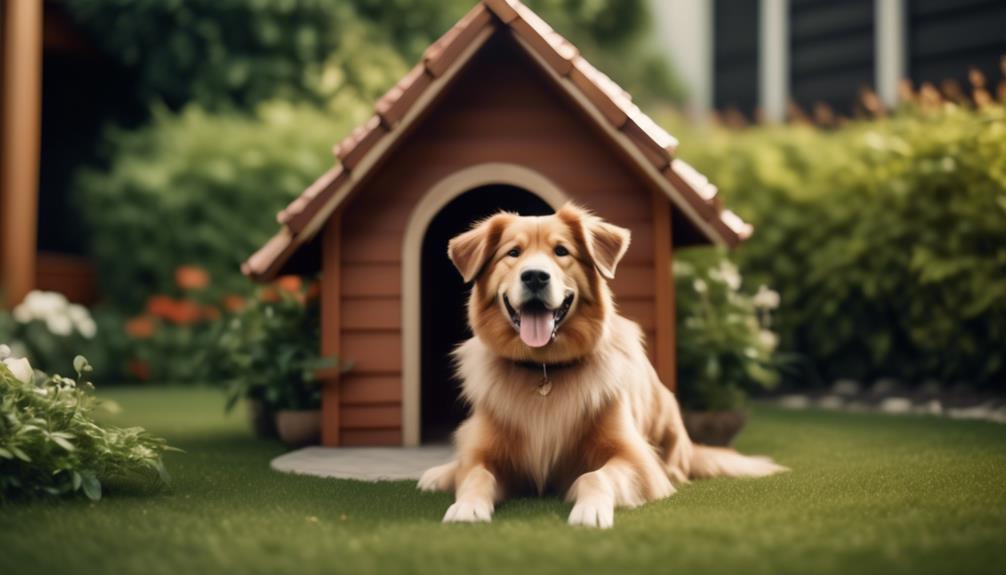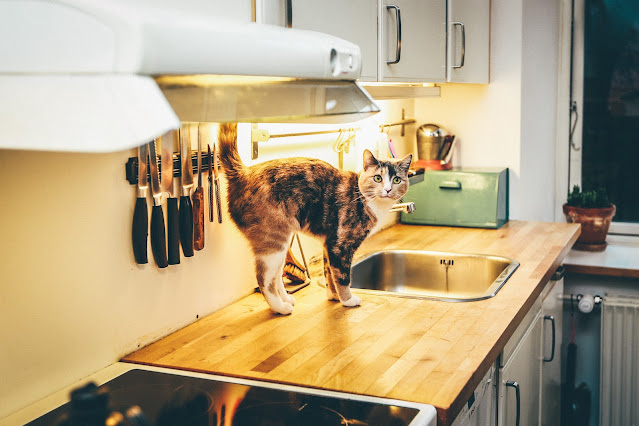5 Excellent Tips For Constructing A Dog House

Tips For Constructing A Dog House: Imagine you’re a dog, running through a vast field with the wind in your fur and the sun on your back. But suddenly, dark clouds roll in, thunder rumbles, and rain starts pouring down. You frantically search for shelter, but there’s nowhere to hide. Just like you, dogs need a safe and comfortable haven, a place they can call their own. If you’re considering constructing a dog house for your furry friend, we’ve got you covered.
In this article, we will explore five excellent Tips For Constructing A Dog House that will guide you in creating the perfect sanctuary for your beloved canine companion. So, let’s dive into the world of dog house construction and discover how to provide the best possible home for your four-legged friend.
Determine the Dog’s Size and Climate
When designing a dog house, it is crucial to carefully consider the size of your dog and the climate in your area. The size of the dog house should be determined by the size of your dog. You want to ensure that your furry friend has enough space to move around comfortably inside the house. If you have a puppy, it’s a good idea to build a larger dog house to accommodate their future growth. It’s better to have a dog house that is slightly bigger than necessary than one that is too small.
In addition to the size of your dog, you also need to take into account the weather and climate conditions in your area. If you live in an area with cold winters, you may want to consider adding extra insulation to the dog house to keep your dog warm. On the other hand, if you live in a hot and humid climate, you may want to choose a material that is resistant to mold and mildew. Wood and plastic are popular choices for dog houses as they are durable and weather-resistant.
When constructing the dog house, it’s important to keep in mind the specific needs of your dog. Some dogs prefer a cozy and enclosed space, while others prefer an open and airy design. Consider your dog’s preferences and behavior when deciding on the layout and design of the house. It’s also important to ensure that the dog house is well-ventilated to prevent overheating during the summer months.
Select the Right Materials
When selecting materials for your dog house, it’s important to prioritize durability and long-lasting protection. Consider using high-quality options like cedar and treated plywood, while avoiding old pressure-treated lumber. Additionally, don’t forget to insulate the doghouse using materials like foam board or fiberglass insulation, sandwiching it between the interior and exterior walls for maximum effectiveness.
Material Selection Guide
To ensure durability and long-lasting protection for your dog house, it is crucial to select high-quality materials such as cedar and treated plywood. These materials are known for their resistance to rot, insects, and harsh weather conditions. For the roof, consider using shingles or metal sheets to provide maximum protection from rain, snow, and sunlight.
Insulation is also important to keep your pet comfortable, especially during extreme temperatures. You can use materials like foam board, fiberglass insulation, or aluminum foil bubble insulation. Additionally, choose a size that is appropriate for your pet, allowing enough space for them to move comfortably. Lastly, if you have the necessary building skills, opt for sturdy construction techniques to ensure the doghouse is secure and stable.
Key Considerations for Materials
Now that you have selected high-quality materials such as cedar and treated plywood for your dog house, it’s important to consider key considerations for materials to ensure you are choosing the right ones. When building a dog house, the size of the doghouse is an important factor to consider. Make sure the materials you choose are suitable for the size of your pet and provide enough space for them to move comfortably. Additionally, it is crucial to protect your pet from extreme weather conditions.
Choose materials that offer insulation and temperature control, such as foam board, fiberglass insulation, or aluminum foil bubble insulation. Consider the weather conditions in your area and select materials that can withstand rain, wind, and heat. Finally, prioritize the safety of your pet by choosing materials that are free from harmful chemicals and safe for your dog to be around.
Choose the Ideal Location
Consider the stability and accessibility of your dog’s future home by selecting a level surface. When choosing the ideal location for constructing a dog house, it is crucial to ensure that the ground is even and firm. This will provide a solid foundation, preventing the structure from sinking or tilting, and ensuring the safety and comfort of your furry friend.
In addition to stability, it is important to provide shade and shelter for your dog. Placing the dog house under a large tree can provide a natural shade, protecting your pet from the scorching sun. Alternatively, consider installing a roof to shield your dog from rain and snow. This will help create a cozy and protected environment, no matter the weather conditions.
Furthermore, take into account the surroundings when determining the ideal location. It is advisable to avoid placing the dog house near busy areas, such as roads or playgrounds, as this may cause stress and anxiety for your dog. Instead, choose a peaceful corner of your yard, away from noise and distractions, where your dog can relax and feel secure.
Lastly, consider the climate and weather conditions of your area. If you live in an area with extreme temperatures, such as hot summers or cold winters, it is important to choose a location that provides adequate insulation and protection. Avoid areas that are prone to flooding or strong winds, as this can compromise the integrity of the dog house.
Design and Build the Dog House
Are you ready to design and build a dog house that meets your furry friend’s needs and withstands the elements? When considering building a doghouse, it is important to keep your dog’s comfort and safety in mind. The primary purpose of the doghouse is to provide shelter, so it is crucial to design and build a structure that will protect your dog from rain, wind, and extreme temperatures.
First and foremost, you need to consider the size of your dog. The doghouse should be spacious enough for your dog to comfortably stand up, turn around, and lie down. It is essential to size the doghouse based on your dog’s full-grown, adult size, rather than its current size.
Next, choose high-quality materials for durability. Cedar and treated plywood are excellent choices as they are resistant to rot and insects. These materials will ensure that the doghouse lasts for a long time, even when exposed to various weather conditions.
To provide additional comfort, incorporate insulation into your building plans. Insulation helps regulate the temperature inside the doghouse, keeping it cool in the summer and warm in the winter. Foam board or fiberglass insulation are effective options to consider.
Lastly, plan for a doghouse that can be easily moved to take advantage of sunlight and shade. This will allow your dog to enjoy the benefits of natural light and fresh air throughout the day.
Add Necessary Finishing Touches
Now that you’ve built the basic structure of the doghouse, it’s time to add those necessary finishing touches. Start by choosing a paint or stain to give the exterior a polished look and protect it from the elements. Consider installing windows to provide natural light and ventilation. And don’t forget to add roof shingles for added protection against rain and snow. These final details will not only enhance the appearance of the doghouse but also ensure your furry friend has a comfortable and cozy space to call their own.
Paint or Stain
To protect your doghouse from the elements and give it a polished look, apply a pet-friendly and non-toxic exterior paint or stain. This step is crucial in ensuring the longevity of your doghouse, especially in extreme weather conditions. When choosing a paint or stain, opt for one that is specifically designed for outdoor use and safe for pets. Consider the color and finish that will complement your home or outdoor space.
Before applying the paint or stain, make sure the doghouse is fully built, including the roof overhang, plywood, and insulation. Apply multiple coats of paint or stain for added durability and protection. Remember to regularly check and touch up the paint or stain to maintain the doghouse’s appearance and weather resistance.
Install Windows
When installing windows in your doghouse, it is important to consider both natural light and ventilation for your furry friend. Natural light helps create a welcoming and comfortable environment for your dog, while proper ventilation ensures fresh air circulation. To install windows, consider the size of your dog and the inside of the doghouse. Position the windows strategically to maximize airflow and create a pleasant atmosphere. Use pet-friendly materials such as plexiglass or tempered glass for safety.
Make sure the windows are securely installed to protect your dog from any potential hazards. Additionally, add the necessary finishing touches by applying trim and caulk around the windows to ensure a weather-tight seal. By incorporating these elements, you can provide a cozy and safe space for your dog inside the doghouse.
Add Roof Shingles
Looking to add the necessary finishing touches to your doghouse? Consider the addition of roof shingles for optimum protection and a polished look. To keep your dogs safe and comfortable, make sure the roof is covered with durable and weather-resistant shingles. This will provide long-lasting protection from the elements. When building a DIY doghouse, it’s important to choose shingles that are large enough to cover the entire roof surface. Proper installation is key to preventing water leakage, so be sure to use the right techniques.
Additionally, consider adding an overhang on the roof to provide extra shelter and protection for your furry friend. Choose shingle colors that complement the overall design and aesthetics of the doghouse to achieve a cohesive and visually appealing look. Don’t forget to secure the shingles properly at the peak of the roof for added stability and durability.
Ensure Safety During Construction
Ensure the safety of your furry friend throughout the construction process by following these practical tips. First and foremost, it is crucial to measure accurately and use sturdy construction techniques to prevent collapses or accidents during extreme weather. A strong and durable doghouse will protect your dog from any potential harm.
When constructing the doghouse, opt for safe and non-toxic materials. This will ensure that your dog is not exposed to any harmful substances that could pose a risk to their health. Additionally, position the doghouse in a shaded area to shield your dog from the sun and inclement weather. This will provide them with a cool and comfortable spot to relax.
To regulate the temperature inside the doghouse and protect your furry friend from extreme heat or cold, consider installing insulation. Foam insulation is an excellent choice as it helps to maintain a comfortable temperature and extend the life of the doghouse. Your dog will appreciate the warmth in colder months and the coolness during hot summers.
Before allowing your dog to use the doghouse, thoroughly check for any protruding screws, nails, or sharp edges inside. These can cause injuries to your pet and should be promptly addressed to ensure their safety. By taking these precautions, you can guarantee a safe and cozy space for your furry friend.
Provide Comfortable Bedding for Your Dog
After ensuring the safety of your furry friend during the construction process, now it’s time to focus on providing comfortable bedding for your dog. Your dog deserves a cozy and warm place to rest, so it’s important to choose the right bedding. You can opt for dog beds, blankets, or even repurpose old carpets to create a comfortable sleeping area for your pet.
When selecting the bedding material, consider your dog’s preferences and habits. Some dogs may prefer softer materials, while others may enjoy something firmer. It’s important to choose a material that will keep your pet comfortable and happy. Additionally, make sure all edges are smooth and free from any sharp objects that could potentially harm your furry friend.
Hygiene is also crucial when it comes to your dog’s bedding. Make sure the bedding is easily washable, so you can maintain cleanliness and prevent odors. Regularly check the bedding for any signs of wear and tear, and replace it if necessary to ensure your dog’s comfort.
During colder seasons, it’s important to provide enough bedding to keep your pet warm. Layering blankets or adding extra padding to their bed can help provide the necessary warmth. Remember, your dog relies on you to keep them comfortable, so make sure to give your pet a cozy and inviting sleeping area.
Tips For Constructing A Dog House Frequently Asked Questions
What Are the 5 Steps to Building a Dog House?
To build a dog house, start by choosing materials like cedar and treated plywood for durability. Measure dimensions to fit your dog’s size. Design the layout with insulation and ventilation. Install a doggy door. Finish with painting and personal touches.
What to Consider When Building a Doghouse?
When building a doghouse, consider material selection, size and dimensions, insulation options, ventilation requirements, flooring considerations, roofing materials and design, and door placement and design. These factors will ensure a comfortable and functional space for your furry friend.
How to Build a House for a Dog?
To build a house for your dog, gather materials like cedar and treated plywood. Determine the size based on your dog’s adult size. Consider insulation, roofing, ventilation, and a well-designed door. Don’t forget about flooring, drainage, and adding personal touches.
How Should a Dog House Be?
To build an ideal dog house, consider the size that fits your dog comfortably. Choose materials like cedar or treated plywood for durability. Insulate the house, provide proper ventilation, and select elevated flooring. Design a secure door and choose suitable roofing options.
Tips For Constructing A Dog House Conclusion
In conclusion, constructing a dog house requires careful consideration of your dog’s needs and the climate. By selecting high-quality materials, ensuring proper sizing and dimensions, planning for mobility and positioning, and adding insulation and ventilation, you can provide a comfortable and safe space for your furry friend. Remember to prioritize safety during construction and provide comfortable bedding for ultimate coziness. With these Tips For Constructing A Dog House in mind, you can create a dog house that meets both your dog’s needs and your own.








